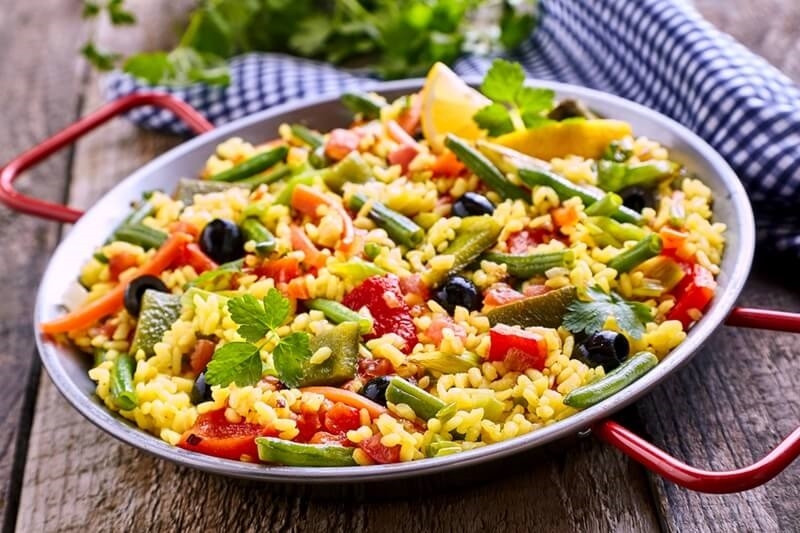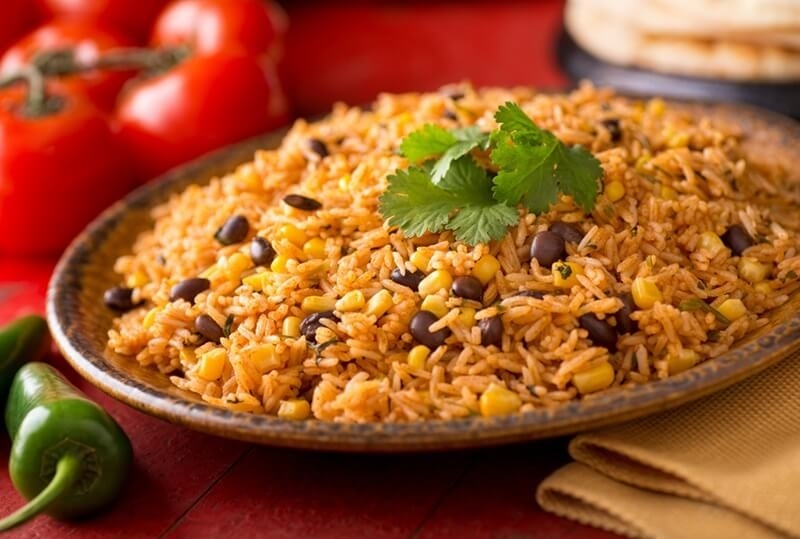
A few dishes bring comfort and taste together, as do Spanish rice and beans. A food for centuries, it is as versatile as it is satisfying. Whether served as a main one-pot rice and beans dish or a side dish, its full flavor, balanced nutrition, and history place it among Spain's most beloved exports to the world's table. For cooks in America who are either learning or relearning how to prepare this food, vegetarian Spanish recipes offer a means of including genuine flavor and comfort in meals each day.
The background of Spanish rice and beans is fascinating. Rice migrated to Spain in the Moorish period, when it was being cultivated in the fertile fields of Valencia. Beans made an appearance in Europe centuries later, having originated in the Americas, and were widely eaten as a staple food. Rice and beans were a natural combination in Spain—grains and beans were a perfect match, producing meals that were filling, affordable, and full of flavor.
As time went by, tomatoes, onions, garlic, and paprika became mandatory ingredients in the easy Spanish rice side dish. Thus, the delectable tomato rice with beans Spain is renowned for today came into being—a gastronomic achievement that is a testament to intercultural exchange, trade, and agricultural practices. Today, this timeless recipe is a mainstay of Spanish comfort food, one that brings on memories of home-cooked meals and family gatherings.

The popularity of Spanish rice and beans goes beyond taste. It's sustenance, heritage, and flexibility. It really has:
It is also one of the most practical vegetarian Spanish recipes, offering depth of flavor without relying on meat. That combination of health, affordability, and satisfaction is why it has traveled so successfully across borders, finding a permanent home in American kitchens.
Great dishes always begin with great ingredients, and Spanish rice and beans are no exception. The ingredients are simple, yet when combined, they yield a richness of flavor:
Rice: Medium-grain rice is standard in Spain, though long-grain rice is employed in the US, as it is a texture people enjoy.
Beans: White beans, kidney beans, or chickpeas are the standard. Each adds a bit of differing texture and taste.
Tomatoes: Fresh or canned, they bring the bright base to tomato rice with beans that Spain is famous for.
Onions and Garlic: Essential flavor producers that enhance the flavor.
Paprika: Sweet or smoked, it gives the dish the traditional Spanish taste.
Olive Oil: A Spanish staple, adding richness and smoothness.
This ingredient list suggests why the dish sometimes goes by the nickname of one-pot rice and beans miracle—the whole set of ingredients comes together in one pot, cutting cleanup and yielding maximum flavor.
Another aspect of the convenience of Spanish rice and beans is how simple it is to prepare. The one-pot rice and beans technique saves time, yes, but also allows flavors to come together.
The recipe begins with the sauté of onions, garlic, and sometimes bell peppers in olive oil. Rice is then added, toasted for just a short while to bring out its nutty flavors. Tomatoes and spices are added next, boiling together until the contents of the pot give off a good smell. The stock is introduced next, followed by beans, and the combination is left to cook slowly until the rice is done and the flavors have merged into one.
It's this technique that it does such an easy Spanish side dish of rice—you don't need multiple pans or fussy steps. A pot, some ingredients, and twenty-half minutes waiting.
Like most classic dishes, Spanish rice and beans is somewhat different depending on the region you are in Spain. In Andalusia, more paprika and saffron can be added, giving the rice a deep, smoky flavor. In Catalonia, white beans are more commonly used, sometimes with seafood added in. Valencia, where rice is popular, might have chickpeas, saffron, and even vegetables that happen to be in season.
These various iterations reference the varied landscapes and cultures of Spain, but at its core, each is true to the comforting blend of tomatoes, beans, and rice. The adaptability of the dish is also why it thrived in the United States, where cooks add its black beans, cilantro, or corn in order to create their own take on this Spanish comfort food.
Although it's more than enough to do it on its own, Spanish rice and beans are an easy Spanish rice side dish to most people. It pairs well with grilled chicken, roasted fish, or even vegetable main courses such as stuffed peppers with ease. Since it has a very strong flavor profile, it never gets overshadowed, even when served with robust dishes.
In tapas platters, it's a foundation note amidst miniature cheese, olive, and cured meat platters. On holiday tables, it tends to sit alongside roasted meats or seafood paellas, proving that even a humble combination of rice and beans can hold its own against more flashy fare.
When people speak of Spanish comfort food, Spanish rice and beans is among the first they think of. Garlic and paprika filling the air, the sight of tomatoes bubbling together with rice, the sensation of a hot bowl being put down before them—it's pure comfort.
It's also super nostalgic. It makes everyone in Spain think about Sunday lunches, family gatherings, or generations' worth of meals. It does the same for Americans, making it at home. Food this comforting doesn't just stuff the belly; it creates an experience, a memory, a tradition.
One reason Spanish rice and beans is becoming increasingly popular in the US is that it naturally satisfies modern concepts of healthy eating. The dish is by nature plant-based, which makes it a vegetarian favorite when in search of Spanish dishes.
A few easy adjustments are:
Such modifications show that even though the dish is highly traditional, it can also accommodate innovation, meaning that the flavor of tomato rice with beans Spain is not compromised.
For many US home cooks, Spanish rice and beans has become a favorite weeknight dinner mainstay. Its simplicity with one-pot rice and beans makes it ideal for busy families with not enough time to cook, and its low price tag ensures that it won't bust the grocery budget.
It also unites cultures. Although similar to Puerto Rican arroz con gandules or Mexican red rice, it is unique due to its own spices and method of preparation. When Americans prepare it in their home, they get to experience Spain but also personalize it based on their own family traditions.
In restaurants across the US, you’ll often see it on menus as a side dish, served with grilled meats or vegetarian mains. In households, it’s often featured at potlucks and gatherings because it’s easy to make in large quantities and appeals to a wide range of palates.
To truly master Spanish rice and beans, attention to detail is key:
These little adjustments can turn an already wonderful dish into something truly exceptional, suitable even for holidays.
Deep at its root, Spanish rice and beans is a dish and a story of history, tradition, and heart. It speaks of cultural fusion, ingenuity when dealing with basic ingredients, and shared affection of abundant, full-bodied cuisine.
Regardless of whether it is served as plain Spanish side dish of rice, incorporated into vegetarian Spanish foods, or loved as Spanish comfort food, it promises delight every time. Its versatility has made it best suited for modern American kitchens, where quick, healthy, and delicious meals are always in order.
Ultimately, tomato rice with beans Spain has perfected remains a culinary gift that continues to inspire. So the next time you’re looking for a dish that combines flavor, nourishment, and tradition, remember this timeless combination. Spanish rice and beans are proof that some of the most remarkable meals are also the simplest.
This content was created by AI